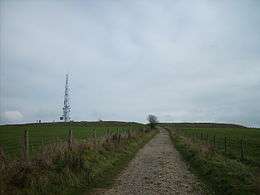Trundle (hill fort)
The Trundle (Old English: Tryndel, meaning "circle")[2][1] is an Iron Age hill fort on Saint Roche's Hill about 3 miles (5 km) north of Chichester, Sussex, England. The fort was built around a Neolithic causewayed enclosure, of which very little can be seen on the ground.
| The Trundle | |
|---|---|
 View of the Trundle | |
| Location | The Trundle in West Sussex, England |
| Coordinates | 50.892585°N 0.753894°W |
| OS grid reference | SU87771103 |
| Area | 5.66 hectares (14.0 acres) |
| Built | Iron Age |
| Reference no. | 246354[1] |
 Location of The Trundle | |
History
St Roche's Hill (elevation 675 feet (206 m)) has been used for several purposes, dating back to the Palaeolithic era. The hill fort was a Neolithic causewayed enclosure before the Iron Age hill fort was built around the pre-existing structure. It is unknown for what purpose the fort was originally built, but the site was used in 1645 by the Clubmen as a military base and subsequently as a beacon site to warn against attack by the French. This beacon was lit in 1745, causing much alarm in the surrounding countryside.[3]
The hill was also the site of a small (around 11 ft × 14 ft (3.4 m × 4.3 m)) chapel, until it was left to ruin. It is thought the chapel was built at some point in the 15th century and destroyed during the Reformation.[3] A windmill was also present on the site of the hill-fort. It is not known when it was built, but in 1773, the windmill burnt down in a storm, along with a windmill on Portsdown Hill.
In World War II, it was the site for a radar early warning system.[4] The summit of St Roche's Hill is now the site of two large radio masts.[2]
The Trundle's northeast slope is a viewing area for Goodwood Racecourse and the top of the hill offers panoramic views of parts of Sussex, Hampshire and the English Channel beyond.[3] In June/July 2010, The Trundle was temporary host to 'Artemis', a 30 ft tall bronze sculpture of a horse designed by sculptor Nic Fiddian-Green.[5][6] The sculpture was taken to Australia in 2011.[7]
Archaeological excavations
During archaeological excavations (1928–1930, 1975, 1980, 1987, 1989 and 1994–95)[8] of the hill fort, numerous objects have been discovered: Middle Iron-Age pottery, potboilers, human bones (an arm bone and a skull), animal bones (ox, horse, pig, dog, cat and sheep), charcoal, various iron objects (including a knife, a spearhead, an adze blade, a sickle, large iron rings and iron slag) and several quern-stone fragments.
See also
References
| Wikimedia Commons has media related to The Trundle. |
- "The Trundle". National Monuments Record. English Heritage. Retrieved 8 March 2011.
- "The Megalithic Portal: The Trundle". Retrieved 16 March 2015.
- "West Sussex.info". Retrieved 16 March 2015.
- "The Trundle". English Heritage.
- "35ft horse's head sculpture graces South Downs". The Argus. 15 December 2010. Retrieved 16 March 2015.
- "Art (visual arts only),Sculpture (Art and design),Art and design,Culture,Horse racing". The Guardian. London. 29 June 2010.
- "Sculpture leaves Goodwood for new home Down Under". Midhurst and Petworth Observer. 8 November 2011. Retrieved 5 March 2013.
- "English Heritage: The Trundle: Investigation history". Retrieved 16 March 2015.